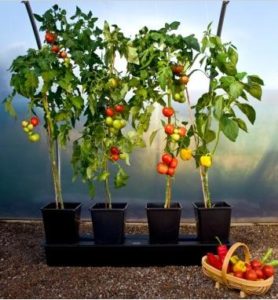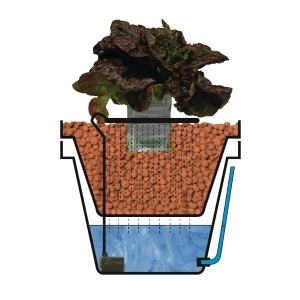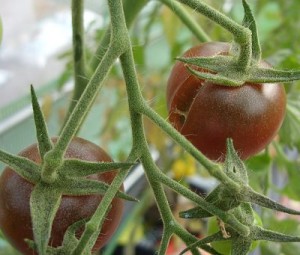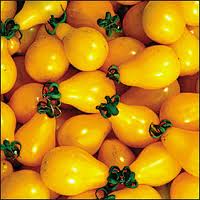It’s about this time of the growing season that I take stock by looking at the successes and challenges that have come along, not just for me, but also for many other tomato growers who have emailed me about their ups and downs.
The most obvious challenge we have all faced in the UK, has been the months of wet, dull weather. This destroyed many gardeners tomato plants completely – especially those who were growing on allotments or outside in the garden and patio.
If We Get Another Wet Season
I think that spraying with a fungicide next season is a necessity for outdoor growers if we get long spells of wet weather again next year. The organic option for outdoor growing in a similar season is probably a non-starter – or at least until we get good and affordable organic fungicides on the market.
Container Growing
Most of us in the UK grow our tomatoes in containers of some kind – large pots or grow bags. These produce good results for a number of reasons but perhaps the main advantage is that we can start with disease free soil.
However, the disadvantage of container growing is the difficulty in keeping the entire root zone moist with water and correctly fed.
Ring Culture
Ring culture – using grow pots in grow bags – partly overcomes these difficulties and helps get the best possible results from a grow bag. However, the next step up from this is a reservoir system.
The Reservoir System
The Quadgrow Planter has out-performed my grow bag/ring culture efforts this season. The Quadgrow Planter (below) is simply a container of water (and nutrients) beneath pots with holes in the bottom.

Capillary matting (acting as a wick) draws up water from below, into the tomato pot above.
This could easily be done using a bucket with a lid, and a tomato pot to sit on the lid. I’m sure that most gardeners could come up with their own version of this reservoir system.
 The important thing is that the lower pot containing the water with food, is light-proof to avoid algae growing. Black plastic buckets would be ideal for this purpose.
The important thing is that the lower pot containing the water with food, is light-proof to avoid algae growing. Black plastic buckets would be ideal for this purpose.
Here’s a rather posh version (left) that pumps water upwards in a constant flow – great stuff, but you will still achieve good result from a more simple setup – placing a pot above a black plastic bucket.
It’s also very good if you are away for a few days as onve the reservoir is filled, it will keep the plants watered for several days depending on the size of the plants and reservoir of course!
I love looking through the seed brochures, but they aren’t always as accurate as they should be.
 One disappointment this season has been Chocolate Cherry, a sister version of Black Cherry. Chocolate Cherry is described as being split resistant but so far I’ve had more split than ones that have not!
One disappointment this season has been Chocolate Cherry, a sister version of Black Cherry. Chocolate Cherry is described as being split resistant but so far I’ve had more split than ones that have not!
Still, the only way to find out is by your own experience – grow it yourself and discover what works best in your garden – just in case those who write the descriptions in the seed catalogues have become a little too optimistic!
Two varieties that are doing well are Large Red Cherry and Beam’s Yellow Pear.
Large Red Cherry is an old collector’s variety with uniform trusses of good size tomatoes and strong growth.
 Beam’s Yellow Pear looks fantastic – perhaps not as intense in taste as many other varieties but the colour and shape make up for it.
Beam’s Yellow Pear looks fantastic – perhaps not as intense in taste as many other varieties but the colour and shape make up for it.
That’s the latest from my garden … if you have any comments about your season so far, please leave them below.


Mark
Hi Nick,
This year has been a disaster to everyone I know. This is my third year of growing tomatoes, and this year has been a real disapointment. I sewed F1 seeds first weekend after easter, and it has been a chore since.
Year 1, I just did as everyone advised and I had bumper crops of Alicante and Shirley tomatoes. We even made 6 jars of Chutney Red and green. Since then I have experimented with different varieties and growing conditions to see which is best.
Next year, I am going to just grow them in my greenhouse, and go back to Alicante, Shirley and my favourite Italian Plum, and no more messin…This year has been a complete failure. :o(
PS, how did the Black Russians turn out this year, I tried them last year and just got BER….
Nick
Hi Mark,
It’s been a very poor season, as you say, and all of my varieties are
well behind schedule.
The Black Russians are doing OK but have still a couple more weeks
before they begin to ripen – I hope we get an Indian Summer, looks like a few good days ahead.
Regards,
Nick
Rhys Jaggar
My first major learning experience is that you can make seeds from F1 hybrids and there doesn’t seem to be a major loss of vigour in the F2 generation.
My experiences of the year are that the tastiest tomatoes on the plate have been the Tumblers and the Alicantes. The Shirleys have cropped well but have not been as sweet to date. I’m looking to do a direct taste comparison between those grown in the ground and those grown in pots. We’ve been using the Shirleys grown in pots in cooking though and freezing some too.
No sign yet of blight on the Shirley tomatoes, although we cut back all the maincrop potato haulms as it looked like they were succumbing. Because we planted the tomatoes right by the hedge facing south, the soil had never seen potatoes and should, therefore, have been free of blight. The first trusses have all ripened and been harvested and at least two more trusses per plant are of a size that would mean that, in the worst case, they could be ripened inside if the plants were struck down with blight.
My thoughts about growing tomatoes outdoors is this: is it possible to construct something akin to a greenhouse without it costing too much?
1. A series of posts to delineate the area for growing, rising 8ft up.
2. A plastic covering which can be clipped over the area to make, in effect, a car port style canopy.
3. The ability to clip further covers around the outer sides for when it rains.
This might give you the benefits of growing in the ground without exposure to rain.
It would require you to dig out the soil each year and replace it with soil from other parts of the garden.
I haven’t looked at what it would cost, but I suspect it would be much less than a traditional greenhouse.
Does anyone know if this has ever been tried for a, say, 7.5m * 4m area capable of housing 30 – 50 plants??
Nick
Hi Rhys,
I have seen something similar on youtube – I think it would work fine.
There are a number of joining clips for canes and tubing too that may be useful.
Here’s a link to one idea for canes, but would probably need guy ropes and tent pegs in windy weather! http://www.amazon.co.uk/Flexi-Build-Joiners-Cloches-Tunnels/dp/B001QT83IU/ref=pd_sim_lp_3
Best wishes,
Nick
David
Hi Nick,
You may remember I wrote a few weeks back saying how ALL my tomato plants on the allotment had died of blight – well, that’s not strictly true as 2 plants managed to survive & I didn’t pull them up at the same time as the rest of the plants. One of the two has managed even to produce some ripe fruit & is even putting out a lot of new growth from the base! The other also has some ripe fruit but I don’t expect it to survive much longer. By the size of the tomatoes I think they are Gardener’s Delight. I remember from 3 years ago that this tomato resisted longer when we got blight (much later in the year ).